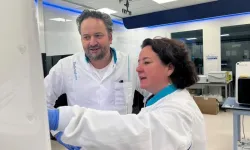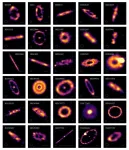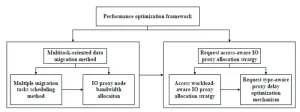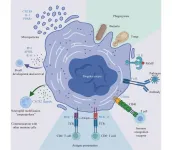(Press-News.org) European consortium for Solving the Unsolved Rare Diseases demonstrates the significance of international collaboration to address the unmet medical needs on rare diseases’ diagnosis
More than 500 European patients with unknown conditions have received a diagnosis through new genetic research. This includes patients with rare neurological disorders, severe intellectual disabilities, muscle diseases, and hereditary gastrointestinal cancer. These diagnoses were achieved through extensive European collaboration, led by researchers from the University of Tübingen, Radboud university medical center, and the National Center for Genomic Analysis in Barcelona.
A disease is considered rare in the European Union, if fewer than 5 out of 10,000people have the condition. Of the 7,000 rare diseases, at least 70% have a genetic cause. Because these diseases are so rare, it's difficult to pinpoint the exact cause in the DNA, even when multiple members of one family have the condition. Researchers have now been able to diagnose a number of European patients and families with their genetic rare disease. These include rare neurological disorders, malformation syndromes and intellectual disabilities, rare neuromuscular diseases, and suspected hereditary cancer risk syndromes.
In total, the researchers reanalyzed the existing genome data of 6,447 patients and 3,197 unaffected family members. Thanks to this research, 506 patients and their families received a diagnosis. For 15% of the patients, there are leads for actionability, in some including treatment; in other cases, the diagnosis provides clarity for the patients and their families. These results have now been published in Nature Medicine.
300 experts
These diagnoses were made possible by Solve-RD, a large European collaboration involving 300 experts from twelve European countries and Canada. Led by researchers from the University of Tübingen, Radboud university medical center, and the National Center for Genomic Analysis (CNAG) in Barcelona, these experts conducted a thorough reanalysis of patients' genetic data. They work within European Reference Networks (ERNs) that focus on specific rare diseases.
Thanks to this framework, it no longer matters whether a patient with a rare condition is seen in the Netherlands, Germany, or France. The method for reaching a diagnosis is now the same everywhere. This did not happen easily. The experts had to agree on the analysis method for each condition, for example, which genes and variant types needed to be examined. Logistical challenges and national legislation and regulations were also of major impact.
Blueprint
This initiative, based on the Solve-RD project's two-level expert review framework, provides a structured approach to diagnosing and potentially treating rare diseases. The framework allows analyses to be reviewed by experts from diverse fields, such as clinical genetics and data science, which increases diagnostic accuracy. The approach is being expanded through the European Rare Disease Research Alliance (ERDERA), a new rare diseases partnership coordinated by INSERM, France, with over 180 organizations including key scientists from Solve-RD. Further acceleration of diagnosis of rare diseases patients being one of its goals, by collecting data from a broader pool of patients and collaborating with additional European medical centers, ERDERA aims to offer diagnoses to those who remain undiagnosed, thus scaling the impact of rare disease research.
Within ERDERA, the University of Tübingen leads the Clinical Research Network diagnostic stream, working again alongside teams from Radboudumc, Barcelona and others across Europe. This includes scaling up patient data reanalysis from 10,000 to over 100,000 rare disease datasets, and covering a wider range of rare genetic conditions. The work also emphasizes the use of advanced techniques such as long-read genome sequencing, optical genome mapping, and RNA sequencing to accelerate diagnoses for unresolved rare conditions.
Holm Graessner, Solve-RD coordinator: ‘The Solve-RD approach to reanalyze data from unsolved rare disease patients was successful and led to a diagnosis for more than 500 patients. This is a major step forward and a milestone for the rare disease research in Europe. We will continue and scale up this approach in ERDERA to provide a diagnosis to even more patients and families across Europe.’
Lisenka Vissers, Professor in Translational Genomics and lead researcher from Radboudumc: ‘We conducted a large reanalysis of an enormous amount of patient data. This allowed us to find similarities and draw conclusions. We have now even been able to provide a diagnosis to a patient who has been ill for twenty years and has participated in many studies.’
Alexander Hoischen, Professor in Genomic technologies for immune-mediated and infectious diseases and lead researcher from Radboudumc: ‘The fact that we have achieved this is a unique example of the power of collaboration. It's a huge step forward in European cooperation, and this is just the beginning. Although we haven't made any new discoveries yet and these diagnoses come from existing data and analyses, we hope to be able to help many more patients in the coming years. Initially by making a diagnosis, but hopefully also with possible treatments.’
About the publication
This research has been published in Nature Medicine: Genomic Reanalysis of a Pan-European Rare Disease Resource Yields New Diagnoses – Steven Laurie, Wouter Steyaert, Elke de Boer, Kiran Polavarapu, Nika Schuermans, Anna K. Sommer, […], Katja Lohmann, Richarda M. de Voer, Ana Töpf, Lisenka E.L.M. Vissers, Sergi Beltran, Alexander Hoischen. This research was conducted by the Solve-RD consortium and within four different ERNs, namely DITF-GENTURIS, DITF-ITHACA, DITF-EURO-NMD, and DITF-RND.
The Solve-RD project has received funding from the European Union’s Horizon 2020 research and innovation programme under grant agreement No 779257. ERDERA has received funding from the European Union’s Horizon Europe research and innovation programme under grant agreement N°101156595. Views and opinions expressed are those of the author(s) only and do not necessarily reflect those of the European Union or any other granting authority, who cannot be held responsible for them.
END
Over 500 patients receive diagnosis through genetic reanalysis
European consortium for Solving the Unsolved Rare Diseases demonstrates the significance of international collaboration to address the unmet medical needs on rare diseases’ diagnosis
2025-01-17
ELSE PRESS RELEASES FROM THIS DATE:
Brain changes in Huntington’s disease decades before diagnosis will guide future prevention trials
2025-01-17
Subtle changes in the brain, detectable through advanced imaging, blood and spinal fluid analysis, happen approximately twenty years before a clinical motor diagnosis in people with Huntington’s disease, finds a new study led by UCL researchers.
The research, published in Nature Medicine, was in collaboration with experts at the Universities of Glasgow, Gothenburg, Iowa, and Cambridge.
The team found that although functions such as movement, thinking or behaviour remained normal for a long time before the onset of symptoms in Huntington’s disease, subtle changes to the brain were taking place up to two decades earlier.
These findings pave the way for ...
U of A astronomers capture unprecedented view of supermassive black hole in action
2025-01-17
Active galactic nuclei are supermassive black holes at the center of certain galaxies. As matter falls into these black holes, enormous amounts of energy are released, making active galactic nuclei, or AGN, one of the most energetic phenomena that can be observed in space. University of Arizona astronomers have now produced the highest resolution direct images ever taken of an AGN in the infrared, using the Large Binocular Telescope Interferometer.
Researchers from the Max Planck Institute for Astronomy in Germany were also involved in the study. The findings are published in the journal Nature Astronomy.
"The ...
Astrophysicists reveal structure of 74 exocomet belts orbiting nearby stars in landmark survey
2025-01-17
Astrophysicists led by a team from Trinity College Dublin have – for the first time – imaged a large number of exocomet belts around nearby stars, and the tiny pebbles within them. The crystal-clear images show light being emitted from these millimetre-sized pebbles within the belts that orbit 74 nearby stars of a wide variety of ages – from those that are just emerging from birth to those in more mature systems like our own Solar System.
The REASONS (REsolved ALMA and SMA Observations of Nearby Stars) study ...
Textbooks need to be rewritten: RNA, not DNA, is the main cause of acute sunburn
2025-01-17
We have all been told to avoid direct sunlight between 12 noon and 3 p.m., seek out shade and put on sunscreen and a hat. Nevertheless, most of us have been experienced sunburn at least once. The skin turns bright red, feels irritated and needs cooling.
You may also have been told that sunburn damages the DNA. But that is not the full truth, the researchers responsible for a new study conducted at the University of Copenhagen and Nanyang Technological University, Singapore (NTU Singapore) explain.
“Sunburn damages the DNA, leading to cell death and inflammation. So the textbooks say. But in ...
Brits still associate working-class accents with criminal behavior – study warns of bias in the criminal justice system
2025-01-17
UNDER STRICT EMBARGO UNTIL 5:00AM (UK TIME) ON FRIDAY 17TH JANUARY 2025
People who speak with accents perceived as ‘working-class’ including those from Liverpool, Newcastle, Bradford and London risk being stereotyped as more likely to have committed a crime, and becoming victims of injustice, a new study suggests.
Received pronunciation (RP) accent perceived as highest status and less likely to commit crimes with the exception of a sexual offence.
Liverpool’s accent most closely associated with criminal behaviour in general.
Welsh, Northern Irish and Scottish accents perceived more positively ...
What do you think ‘guilty’ sounds like? Scientists find accent stereotypes influence beliefs about who commits crimes
2025-01-17
The way you talk says a lot about you — but what people think it says may not be true. While no accent is better than any other, people use accents as markers for identifying and stereotyping social groups. In the justice system, these accent stereotypes could influence perceptions of guilt, leading to discrimination. Scientists collaborating on the Improving Voice Identification Procedures project explored this by testing participants’ perceptions of ten different accents heard around the UK. They found that speakers with accents considered lower-status were considered more ...
University of Calgary nursing study envisions child trauma treatment through a Marvel and DC lens
2025-01-17
Perhaps you’ve heard the story of Peter Parker, raised by his aunt and uncle after the death of his parents only to see his uncle murdered by the same criminal the radioactive spider-bitten teen neglected to apprehend that very day. His guilt drives him to become Spider-Man.
But childhood trauma doesn’t always inspire super-heroics. Heath Ledger’s psychotic Joker, as seen in 2008 film The Dark Knight, recounts tales of horrific abuse by a father who disfigures him. It’s a stark contrast to his heroic nemesis Batman, who saw his parents gunned down in ...
Research on performance optimization of virtual data space across WAN
2025-01-17
For the high-performance computing in a WAN environment, the geographical locations of national supercomputing centers are scattered and the network topology is complex, so it is difficult to form a unified view of resources. To aggregate the widely dispersed storage resources of national supercomputing centers in China, the team led by Zhisheng Huo have previously proposed a global virtual data space named GVDS. However, the GVDS suffers from performance bottlenecks in data migration and access across WANs.
To solve the problems, ...
Researchers reveal novel mechanism for intrinsic regulation of sugar cravings
2025-01-17
Excessive sugar consumption is linked to several non-communicable diseases, including obesity, cardiovascular disease, metabolic syndrome, and type 2 diabetes. Animals naturally crave sugar, and uncontrolled sugar preferences can lead to high sugar intake, raising the risk of hyperglycemia and metabolic diseases.
Previous research suggests that food cravings in humans are driven by signals from the gut to the brain, highlighting the gut's crucial role in shaping dietary preferences. However, the regulation of sugar preference is complex, and the specific influence of gut microbes remains unclear.
In a study published in Nature Microbiology, ...
Immunological face of megakaryocytes
2025-01-17
Megakaryocytes (MKs), known for their role in platelet production, have emerged as critical players in immune responses, showcasing versatility in both physiological and pathological contexts. Recent advances in technology have unveiled the diverse immune functions of MKs, which express immune sensors and participate in immune activities, thus expanding their traditional role beyond hemostasis and coagulation. This comprehensive review delves into the multifaceted immune roles of MKs, highlighting their distinct immunological roles under ...
LAST 30 PRESS RELEASES:
Making lighter work of calculating fluid and heat flow
Normalizing blood sugar can halve heart attack risk
Lowering blood sugar cuts heart attack risk in people with prediabetes
Study links genetic variants to risk of blinding eye disease in premature infants
Non-opioid ‘pain sponge’ therapy halts cartilage degeneration and relieves chronic pain
AI can pick up cultural values by mimicking how kids learn
China’s ecological redlines offer fast track to 30 x 30 global conservation goal
Invisible indoor threats: emerging household contaminants and their growing risks to human health
Adding antibody treatment to chemo boosts outcomes for children with rare cancer
Germline pathogenic variants among women without a history of breast cancer
Tanning beds triple melanoma risk, potentially causing broad DNA damage
Unique bond identified as key to viral infection speed
Indoor tanning makes youthful skin much older on a genetic level
Mouse model sheds new light on the causes and potential solutions to human GI problems linked to muscular dystrophy
The Journal of Nuclear Medicine ahead-of-print tip sheet: December 12, 2025
Smarter tools for peering into the microscopic world
Applications open for funding to conduct research in the Kinsey Institute archives
Global measure underestimates the severity of food insecurity
Child survivors of critical illness are missing out on timely follow up care
Risk-based vs annual breast cancer screening / the WISDOM randomized clinical trial
University of Toronto launches Electric Vehicle Innovation Ontario to accelerate advanced EV technologies and build Canada’s innovation advantage
Early relapse predicts poor outcomes in aggressive blood cancer
American College of Lifestyle Medicine applauds two CMS models aligned with lifestyle medicine practice and reimbursement
Clinical trial finds cannabis use not a barrier to quitting nicotine vaping
Supplemental nutrition assistance program policies and food insecurity
Switching immune cells to “night mode” could limit damage after a heart attack, study suggests
URI-based Global RIghts Project report spotlights continued troubling trends in worldwide inhumane treatment
Neutrophils are less aggressive at night, explaining why nighttime heart attacks cause less damage than daytime events
Menopausal hormone therapy may not pose breast cancer risk for women with BRCA mutations
Mobile health tool may improve quality of life for adolescent and young adult breast cancer survivors
[Press-News.org] Over 500 patients receive diagnosis through genetic reanalysisEuropean consortium for Solving the Unsolved Rare Diseases demonstrates the significance of international collaboration to address the unmet medical needs on rare diseases’ diagnosis




